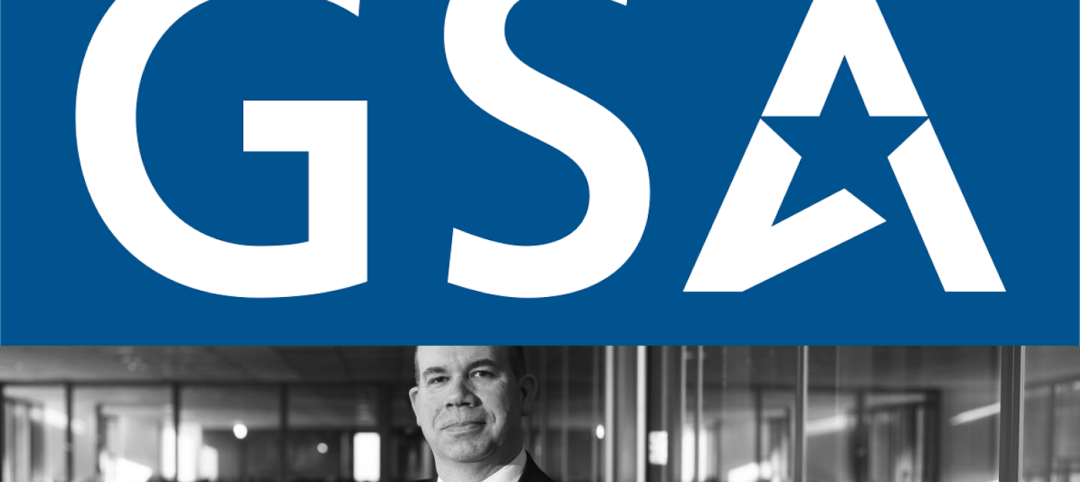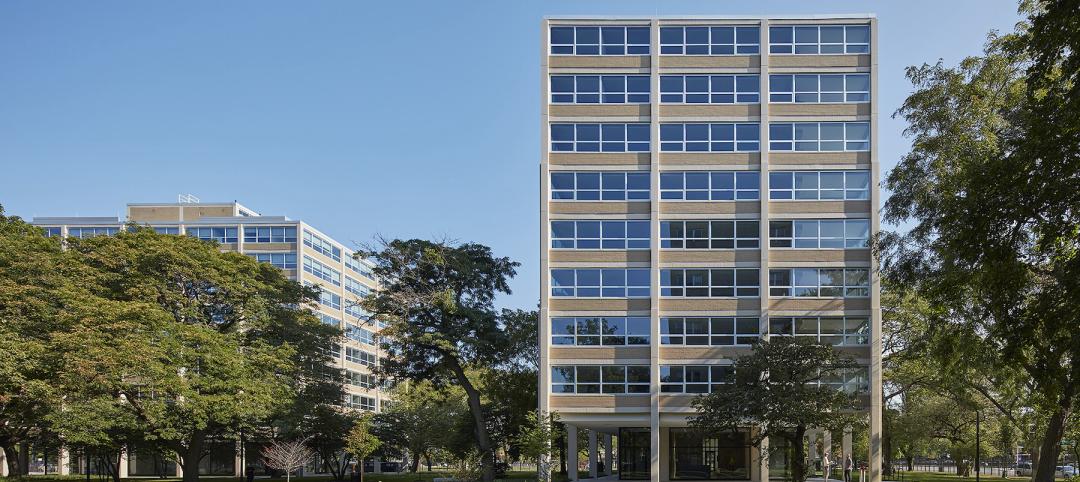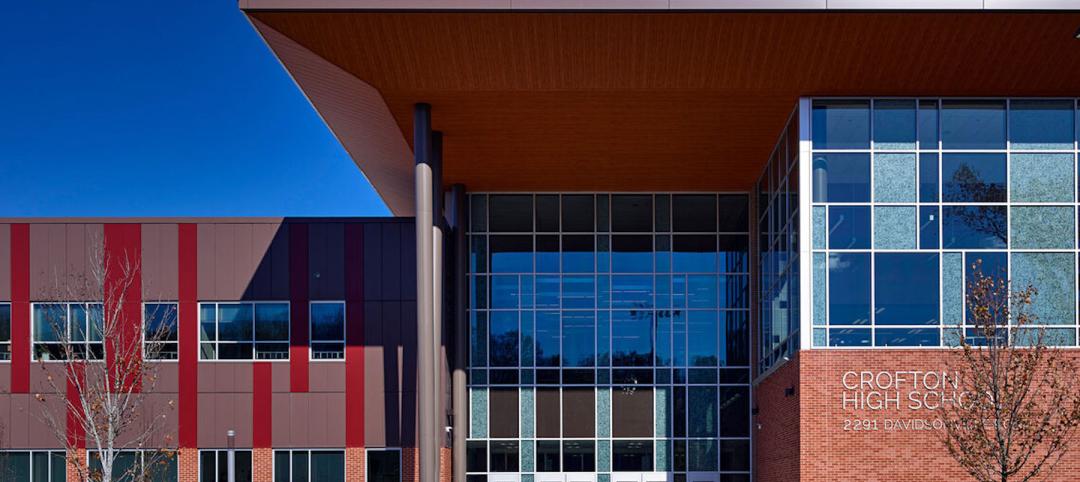From its founding in 1979, the Mid-Ohio Foodbank has performed yeoman’s service in receiving, sorting, and distributing food to tens of thousands of Ohio families.
By 2006, however, it had outgrown its 71,000-sf facility. The loading docks were no longer up to the task of shipping tens of millions of pounds of food a year. Offices were cramped. There wasn’t enough space for training and volunteer activities. It was time for a change—not merely a change of venue, but one that held the prospect of transforming the whole organization for the better.
Matt Habash, Mid-Ohio’s president and CEO, and his board set four key goals for the project: 1) Showcase the food bank’s mission; 2) Foster cultural change in the organization; 3) Provide flexibility, adaptability, and expandability; and 4) Make the building sustainable.
After touring a number of food banks in the Midwest, holding design charrettes with Mid-Ohio staff and food bank leaders from around the country, and conducting an analysis of the existing facility, a Building Team assembled by Columbus, Ohio-based Rogers Krajnak Architects concluded that the food bank had to look for a new location.
With a construction budget of only $9 million, the team wisely chose to renovate a 190,000-sf mattress factory into a modern, multifunctional food bank that would exceed Habash’s four-goal mandate.
Showcasing the mission. The Building Team organized the building so that visitors get a sense of the food bank’s mission as they pass a food garden on their way to the main lobby. The central two-story, skylit lobby provides views of the many volunteers sorting and packing food, while a double-height glass bay at the end of the lobby offers a view into the drygoods racking area, where thousands of pallets of food are stacked. Making the function of the building more apparent to the public can have a positive impact on fundraising and volunteering.
Designing for flexibility and growth. The 125,000-sf warehouse space was designed to be able to accommodate 4,300 pallet positions. The Building Team devised a way to enable the racking system to be expandable by installing additional rows of racks within the existing width of the aisles. Freezers and refrigerators take up 12,500 sf; along with warehouse racking, this space is designed for future expansion.
Fostering organizational change. The move to a new building was viewed by management as an opportunity to create a more egalitarian and collaborative work environment and enhance communication between the office and warehouse staffs.
The Building Team responded by creating administration areas in open-office spaces, mostly on the upper-level mezzanine. Perimeter offices have no doors but do have lots of glass on interior walls for enhanced daylighting and visibility.
Another organizational goal was the desire to engage the community more fully. In the past year, the new food bank’s meeting/conference spaces have hosted more than 1,500 meetings for volunteer groups, corporate workshops, training sessions, and similar outreach activities. The 400-seat community room has advanced A/V capability as well as a fully equipped demonstration and commercial catering kitchen where nutrition education programs are conducted.
Achieving sustainability. Although the early goal was to gain LEED Silver certification, the project earned Gold status (under LEED NC 2.2) through such strategies as the reuse of materials from the old building (metal liner panels, insulation, concrete), installation of bioswales, and the use of climate-appropriate landscaping. Operable windows, exterior sunshades, and metal panel building fins bring daylight into the building while controlling glare and heat buildup
Other LEED benchmarks: 30% water reduction via water-efficient fixtures, 95% diversion of construction waste from landfill by GC Ruscilli Construction, and over 20% recycled content in construction materials (more than 30% regionally sourced).
Currently, the Mid-Ohio Foodbank distributes over 38 million pounds of food a year to over 500 partner agencies in 20 Ohio counties—enough food to provide 55,000 meals a day for hungry Ohioans. More than 10,000 volunteers contribute 38,000 hours of service annually.
The judges were unanimous in granting a Platinum Award, the highest honor, to the project. “The interior is so functional. There’s a nice blend of spaces—working space, community space, office space,” said K. Nam Shiu, SE, PE, MISE, VP of Walker Restoration Consultants, Elgin, Ill.
The most compelling aspect of this project is how the Building Team took a nondescript building and turned it into an elegant and highly functional community asset. As Martha Bell, FAIA, principal, Tilton, Kelly + Bell, Chicago, puts it, “The team took a plain box and transformed it. It works on every level. This is a great model for this type of building.”
PROJECT SUMMARY
Building Team
Submitting firm: Rogers Krajnak Architects, Inc. (architect, interiors)
Owner/developer: Mid-Ohio Foodbank
MEP/fire protection engineer: Korda
Structural engineer: Shelley Metz Baumann Hawk, Inc.
GC: Ruscilli Construction Co.
Landscape architect: Kinzleman Kline Gossman
LEED consultant: Heapy Engineering
General Information
Size: 204,700 gsf (including 14,763 sf new interior construction)
Construction cost: $9.0 million
Construction period: June 2008 to September 2009
Delivery method: Design-bid-build
Related Stories
Giants 400 | Aug 19, 2022
2022 Giants 400 Report: Tracking the nation's largest architecture, engineering, and construction firms
Now 46 years running, Building Design+Construction's 2022 Giants 400 Report rankings the largest architecture, engineering, and construction firms in the U.S. This year a record 519 AEC firms participated in BD+C's Giants 400 report. The final report includes more than 130 rankings across 25 building sectors and specialty categories.
| Aug 19, 2022
Cuningham appoints Jacqueline Dompe as new Chief Executive Officer
Cuningham, a national design firm, is thrilled to announce the appointment of Jacqueline Dompe as the firm’s Chief Executive Officer (CEO).
| Aug 19, 2022
Future sea rise could expose 720,000 more people on East Coast to flooding
An analysis by NPR based on modeling from the National Hurricane Center for New York City, Washington, D.C., and Miami-Dade County found future sea rise could expose about 720,000 more people to damaging floods later this century.
| Aug 19, 2022
Manassas Museum renovated to reimagine a civic design & engage the community
Manassas, VA has recently added to its historic Manassas Museum.
Architects | Aug 18, 2022
GSA names Charles Hardy, AIA, CCM, Chief Architect at GSA Public Buildings Service
The U.S. General Services Administration (GSA) has named Charles (Chuck) Hardy as GSA’s next Chief Architect, effective August 14, 2022. A licensed architect, workplace strategist, and certified construction manager, Hardy’s career with GSA spans more than 31 years, beginning in GSA’s Great Lakes Region as an architect and project manager.
| Aug 18, 2022
U.S. Treasury moves to boost affordable housing
The Department of the Treasury recently announced new guidance to “increase the ability of state, local, and tribal governments to use American Rescue Plan (ARP) funds to boost the supply of affordable housing in their communities,” according to a news release.
Daylighting | Aug 18, 2022
Lisa Heschong on 'Thermal and Visual Delight in Architecture'
Lisa Heschong, FIES, discusses her books, "Thermal Delight in Architecture" and "Visual Delight in Architecture," with BD+C's Rob Cassidy.
| Aug 18, 2022
The Illinois Institute of Technology restores three Mies van der Rohe buildings
With Dirk Denison Architects and Gilbane Building Company, the Illinois Institute of Technology has recently completed a $70 million housing project that has restored three Ludwig Mies van der Rohe buildings.
Multifamily Housing | Aug 17, 2022
California strip mall goes multifamily residential
Tiny Tim Plaza started out as a gas station and a dozen or so stores. Now it’s a thriving mixed-use community, minus the gas station.
| Aug 17, 2022
Focusing on building envelope design and commissioning
Building envelope design is constantly evolving as new products and assemblies are developed.

















